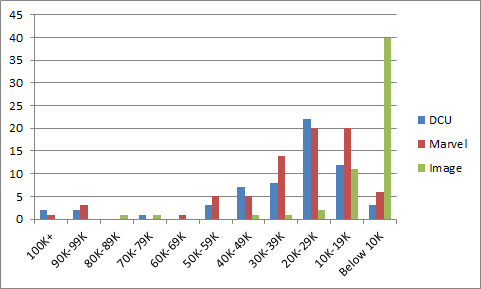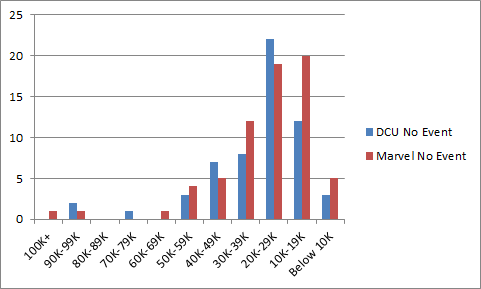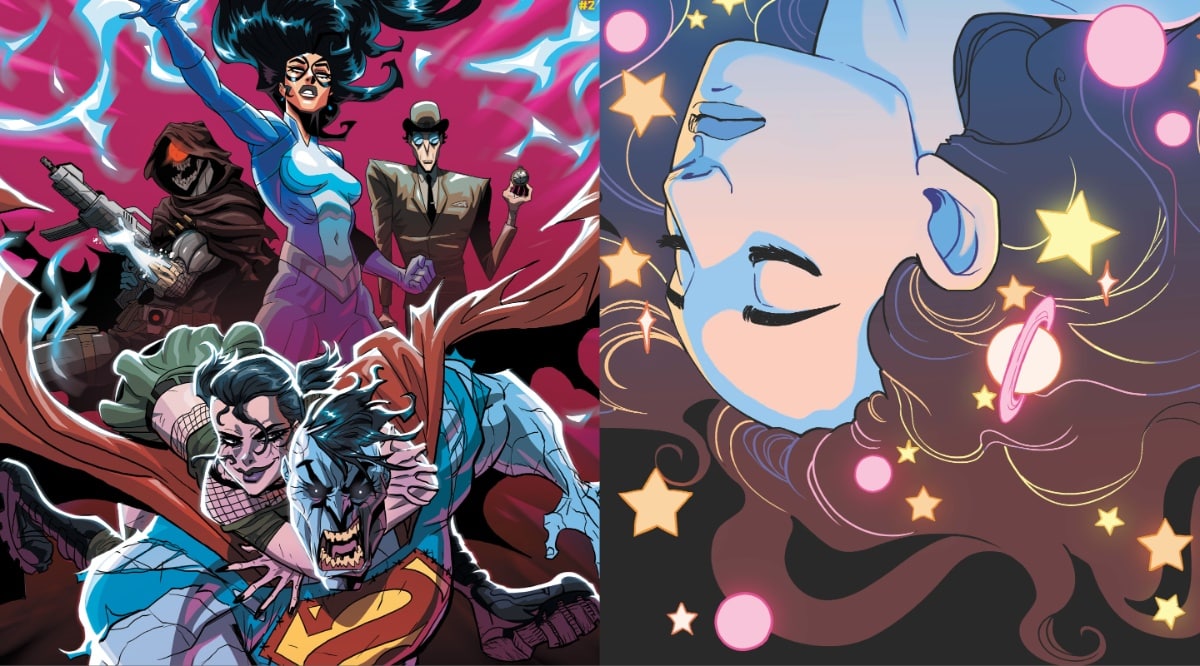And finally, the comparison chart of DC, Marvel and Image. So we can see where the biggest sales sit on the Direct Market Landscape.
Standard disclaimers: The numbers are based on the Diamond sales charts as estimated by the very reliable John Jackson Miller. These charts are pretty accurate for U.S. Direct Market sales with the following caveats: 1) you can add ~10% for UK sales, which are not reflected in these charts; 2) everyone’s best guess is you can add ~10% for digital sales – while some titles do sell significantly better in digital (*cough* Ms. Marvel *cough*), that’s the average rule of thumb; 3) it’s not going to include reorders from subsequent months, although reorders will show up in subsequent months if they’re high enough. So if you’re a monster seller in Southampton and it took the US audience 3 weeks to reorder, it’s probably not going to be reflected here.
What’s a sales band? It’s another way to have a higher level view of the market. The general idea is to divide the market into bands of 10K copies sold and see how many issues are in each band. How many issues sold between 90-99K copies, 80-89K copies, etc. etc. In very broad terms, the market is healthier when there are several titles selling in the 70K-100K+ range because titles that move a lot of copies give the retailers some margin of error on their ordering. When you see titles selling in the 20-29K band and especially below, there’s a pretty good chance a lot of retailers aren’t ordering those titles for the shelf (pull box/pre-order only) or minimal shelf copies at best.
This month is one of those months that illustrates exactly why Image goes on the same chart as DC and Marvel. Oh, sure. There’s an absurd amount of volume selling under 10K, but this month there are two hits in the no man’s land between 59K and 89K that DC and Marvel seem to have so much trouble placing issues into. We’ll see how Oblivion Song holds up over time, but Kirkman got the initial orders. (We’ll also eventually find out if Gideon Falls has been under-ordered and is more of a breakout than initially thought – lots of extra printings going on with that one.)
Past that, we’re seeing a little more parity between DC and Marvel. On that note, let’s take a look at DC and Marvel without the Events:
Feel free to debate whether Dan Slott’s final Spidey arc and the end of the Jane Foster Thor run are events or not. I’m counting them as culminations of long running arcs a hair more than stunts… that said, when was the last time you could make a credible argument that Marvel was having a better month on the top list that DC when you ignored the #1s and Events? It’s been a while.
Oh sure, this is supposed to be a measure of sustainable business and there are legitimate questions about whether Amazing Spider-Man and Thor will sustain these sales levels, but that’s what the chart says this month.
DC and Marvel are more alike than ever this month, in terms of sales distribution. You’d like to see both of them have more issues falling in the 30K+ categories, but they’re flipping positions from category to category and in March, you can’t really one was particularly more impressive without sell through data.
As I’ve commented in both the DC and Marvel individual charts, we’re counting down the days until both companies start their relaunches. They NEED the relaunches because of the overall flood of low circulation titles and lack of a robust top list. Whether or not the relaunches click with readers may provide a little more separation, but by the time orders are adjusted, the sales charts may not reflect the real winners until the end of summer.
Want to learn more about how comics publishing and digital comics work? Try Todd’s book, Economics of Digital Comics











Ugh. These numbers are so sad I cant look at them anymore. DC and Marvel better find someone else to produce their books pronto.
It’s about to get even better. All these overpriced Marvel “anniversary” issues are being followed up by relaunching the titles with double shipped first months, and also with $4.99 to $5.99 “first” issues. Do they want to burn down all the goodwill they’ve just earned? I’m dropping Thor and Amazing Spider-Man (both I have been enjoying) thanks to these predatory gimmicks.
That’s interesing, Nick. I recently made the decision to pick up Miller’s new Xerxes series at what I presume is $4.99 per issue, and I had some Sin City comics out, cover-priced at $2.99 and published in 1994! Two dollars in twenty three years; Miller goes for production values inbuilt into his pricing, I would say. Pricing Marvel #1s at $6 does seem excessive. Don’t blame you.
“Do they want to burn down all the goodwill they’ve just earned?”
Marvel earned some good will? Haw! Same band of merry idiots driving the car off the cliff once again…
Comments are closed.